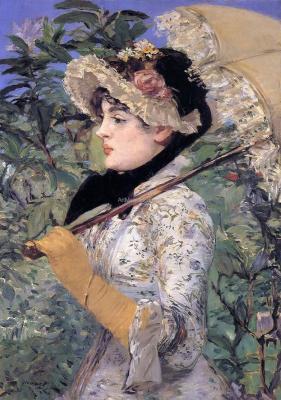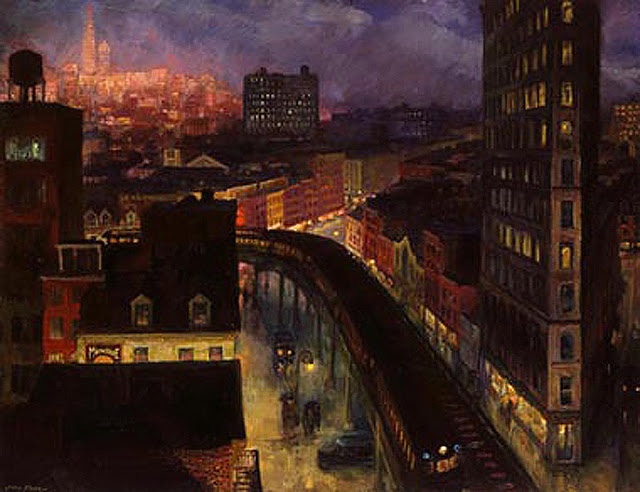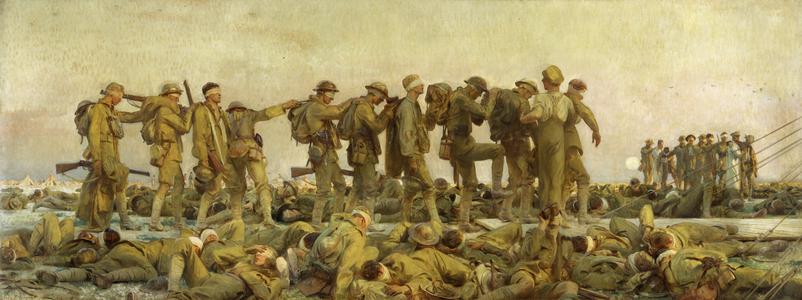James Tissot was a French painter who moved to England after the collapse of the Paris Commune in 1870, and returned to Paris some ten years later. During his career, he was both prolific and well paid. He made his name as a society painter, portraying fashionable women in good clothes and in appropriate settings. Later in life,Tissot devoted himself to Biblical paintings which are noteworthy for the sculpture-like rendering of Biblical figures, though the emotions of grief or piety that accompany them seem somewhat cliched. There is, however, one picture of his, “Hide and Seek”, created in 1877, that is very different from either of his two major periods, and it stands out as worthy of attention, and makes Tissot one of those artists that produces just a few memorable paintings rather than an artist who keeps producing them throughout the course of a career. For one moment, inspiration caught up with talent.
“Hide and Seek” is set in a large living room. On the right there is a door which opens onto a garden, but this is not a picture of the outdoors as seen from the indoors. Another widow with a view of the outside has a white window shade drawn down on it so that the outside is not visible, which helps the viewer return to the interior of the room as the painting’s subject matter. The room is furnished in Victorian style: overstuffed sofas, tables, ornamented carpets, all set far away from one another so that the room does not seem at all cramped while remaining quite homey. Critics have emphasized that this was a time in his life when Tissot was quite happy, having settled down with the mistress who gave him a son. She may be the person who is leisurely occupying a sofa with her feet up, reading a newspaper, the moment a sad one because she would die within a few years. So this is a bourgeois domestic idyll and so to be savored for how charming and pleasant bourgeois life can be.
There is more to the picture, though, and it refers to a paradox of bourgeois life not easily fathomed. There are four children in the picture, all similar and cherub like. The one at the center and the main focus of the picture is sitting on the floor and looking at a ball that is a bit removed from her, it also a strategic object in the painting. Why is she looking so carefully at the ball? This, the grown woman neglects to do so, perhaps because it is only a toy there for the amusement of the children. But there is something about the ball that perhaps only children, or the naive, or else the very perceptive, will notice. The ball is geometrically round and it is unadorned. That is different from the furniture, which is plushly upholstered and has numerous cushions, and from the rugs, which have elaborate floral designs. The starkness of the ball makes it something from another world. It is a geometric form not in the abstract, as in a geometry textbook, but actualized as a concrete thing out of keeping with its surroundings, and so is a symbol as well as a representation of what is ultimate and universal in the midst of the everchanging. The girl notices this about the ball the people around her do not. The ball serves as a critique of the pleasures and comforts of the bourgeois world, which will inevitably fade, while what the ball is and represents will not fade, and yet, ironically, the ball is just a plaything on the floor, however much it takes over the picture, that now focussed on its right hand lower quadrant where the ball lies. The ball as an abstract and yet present object, a part of the natural rather than the socially created world because it is a part of geometry which rules, in its way, aside from what people do, is therefore a challenge to the world in which the child is immersed, and the child knows that, and the problem set up by the painting is what the child as well as the viewer will make of that.
The ball constitutes such a challenge because it is so different from the clutter of ostentatious decoration that dominates the Victorian Age and which serves to remove civilization from its underpinnings in reality. In the Victorian era, civilization is understood as an imposition upon nature, and human society a construction that keeps people from being, as an image of the age that endures has it, in a constant evolutionary struggle where the strong defeat the weak. Society is a product of history and takes on its own representations that are not obliged to or reflective of the pre-social or primitive social forces that may underlie them. That is what makes society so comfortable and comforting. To do this, everything from architecture to household furnishings to dress indicate an artificiality that contrasts with the natural and even goes so far as to appropriate what might seem to be the natural to its own purposes, as when flowers are adopted to decorate rugs and so become part of human life rather than natural life.
The ball as an abstract object and yet a real object is an image that could not be used for much longer as an image of the universal inhabiting the historical world. In the Eighties, Lewis Carroll introduces a wonderland where the laws of logic stand out in high relief. Alice becomes smaller and then bigger contrary to physical law; the Cheshire Cat ceases to take up space, in violation of biological law; and, to top it off, the Queen demands a verdict before a trial, which is a violation of social law. And after that would come Freud’s cluttered office, opulent and busy in the Victorian style, but with the addition of statues and artifacts from primitive societies to add credence to the idea that there are levels of consciousness and experience that go beyond and are coexistent with the normality of bourgeois life. Nor will it be long before geometrical shapes take over painting and architecture and room decoration, however much the rectangles of Sullivan office buildings still use decorative motifs. But Tissot is not yet in that period and so geometry is an intrusion into bourgeois life, which raises the question of why bourgeois life was so committed to plush and over-elaborate decoration.
But this one picture should not lead to neglecting the paintings on which Tissot’s fame was based. Tissot’s portraits are not bad even though they never take a grip on the viewer the way that the portraits of John Singer Sargent do, whether that is because Tissot does not have Sargent’s mastery of color or because Tissot’s faces are too realistic and so do not have the mystery and individuality that Sargent’s do, or because they look too much alike, with pert noses and small lips, his women dressed more often than not in white, or simply because current taste for some reason does not favor him. But a more limited case can be made for them. Tissot sets his portraits in interesting places: outdoors, in parks, in living rooms, on ships, and so they constituted a record of what fashionable (and not so fashionable) women did with their time. In some cases, the clothes of the women he portrays are carefully represented and complex and their faces are distinctive. Moreover, the women are shown to be poised, comfortable in themselves, and so a match for the stagey men who accompany them. That provides evidence that should unsettle the view that the women of the Victorian Age are prim and oppressed. They seem very much in command of their surroundings even if they do not have seats in Parliament.











